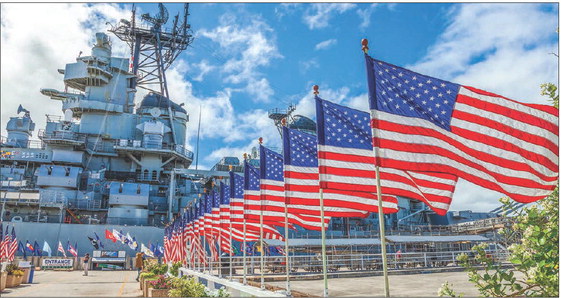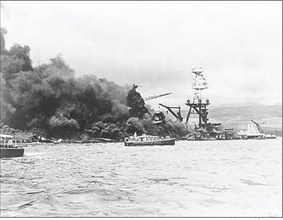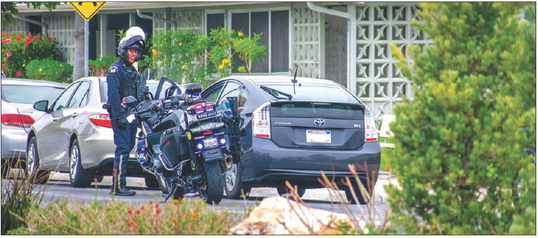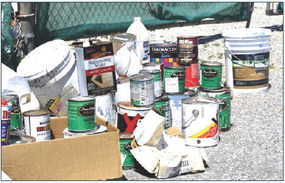Pearl Harbor—A date that lives in infamy


President Franklin Roosevelt called Dec. 7, 1941, “a date which will live in infamy.”
On that day, Japanese planes attacked the United States Naval Base at Pearl Harbor, Hawaii.
The bombing killed more than 2,300 Americans and decimated the U.S. Pacific Fleet. It destroyed the American battleship USS Arizona and capsized the USS Oklahoma.
The attack sank or beached a total of 12 ships and damaged nine others; 160 aircraft were destroyed and 150 others damaged. The country was taken by surprise, especially the ill-prepared Pearl Harbor base.
When Germany and Italy declared war on the United States days later, America found itself in a global war.
The annual Remembrance Day ceremony commemorating the attack on Pearl Harbor will be closed to the public this year and streamed online as a result of the coronavirus pandemic.
The ceremony will begin at 7:50 a.m. on Dec. 7 at the Pearl Harbor National Memorial’s Contemplation Circle in Hawaii.
A small number of veterans will be in attendance on-site, according to Hawaii News Now.
A moment of silence will be observed at 7:55 a.m., the time when the Japanese attack on the American naval base began in 1941.
The entire event will be livestreamed on Pearl Harbor National Memorial’s Facebook page and at www.pearlharborevents. com in partnership with Defense Media Activity.
“America’s obligation to honor its veterans has been a sacrosanct pillar of our society, and we encourage everyone to join us virtually for this important ceremony,” said Scott Burch, acting superintendent of Pearl Harbor National Memorial.
THE ATTACK
On Nov. 26, 1941, the Japanese Imperial Navy ordered an armada that included 414 planes aboard six aircraft carriers to set to sea, according to nationalWWIImuseum. org. Following a plan devised by Adm.Yamamoto Isoroku, who had earlier studied at Harvard and served as Japan’s naval attaché in Washington, D.C., the flotilla aimed to destroy the U.S. Pacific Fleet base at Pearl Harbor.
To catch the Americans by surprise, the ships maintained radio silence throughout their 3,500-mile trek from Hitokappu Bay to a predetermined launch sector 230 miles north of the Hawaiian island of Oahu.
At 6 a.m. on Sunday, Dec. 7, a first wave of Japanese planes lifted off from the carriers, followed by a second wave an hour later. Led by Capt. Mitsuo Fuchida, the pilots spotted land and assumed their attack positions around 7:30 a.m. Twenty-three minutes later, Fuchida broke radio silence to shout, “Tora! Tora! Tora!” (Tiger! Tiger! Tiger!)—the coded message informing the Japanese fleet that they had caught the Americans by surprise.
The unsuspecting American ships were moored in pairs along Pearl Harbor’s “Battleship Row.” For nearly two hours, Japanese firepower rained down upon American ships and servicemen.
While the attack inflicted significant destruction, the fact that Japan failed to destroy American repair shops and fuel-oil tanks mitigated the damage.
Even more significantly, no American aircraft carriers were at Pearl Harbor that day. The Japanese, however, immediately followed its Pearl Harbor assault with attacks against U.S. and British bases in the Philippines, Guam, Midway Island, Wake Island, Malaya and Hong Kong. Within days, the Japanese dominated the Pacific. In Washington, a decrypted message had alerted officials that an attack was imminent moments before Fuchida’s planes took to the skies.
But a communications delay prevented a warning from reaching Pearl Harbor in time. The Americans missed another opportunity when an officer discounted a report from an Oahu-based radar operator that a large number of planes were headed their way.
According to history, Roosevelt learned of the attack as he was finishing lunch at the White House.
He spent the remainder of the afternoon receiving updates and writing the address he intended to deliver to Congress the following day asking for a declaration of war against Japan. As he drafted and redrafted the speech, Roosevelt focused on rallying the nation behind a war many had hoped to avoid.

The U.S. Navy took this photo of the USS Arizona on fire, following the Japanese attack on Pearl Harbor, Hawaii, on Dec. 7, 1941.Library of Congress



